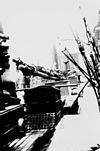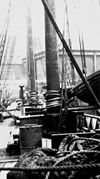Мэри Б. Митчелл (шхуна)

| |
| История | |
|---|---|
| Имя | Мэри Б. Митчелл |
| Владелец | Джонс, Престон, лорд Пенрин, Уильям Томас, Королевский флот, Иова Тиррелл, Джеймс Тиррелл |
| Порт реестра | Англси, Дублин |
| Строитель | Пол Роджерс, Каррикфергус |
| Запущен | 1892 |
| Введено в эксплуатацию | 1893 |
| В эксплуатации | 1893-1944 |
| Судьба | Разбитый 14 декабря 1944 года |
| General characteristics | |
| Tonnage | 227 gross tons[1] |
| Length | 129' 7" |
| Beam | 24' 4" |
| Depth | 10' 8" |
| Propulsion | sail + auxiliary motor |
| Armament |
|
| Notes | motor & armaments fitted 1916, disarmed 1919 |
Мэри Б. Митчелл была британской, а затем ирландской шхуной , ласково известной как Мэри Б .. Она была удовольствием, героем войны, работающей шхуной, кинозвездой и транспортером важных грузов в опасных водах.
Построенная в 1892 году она несла сланец из Уэльса. В 1912 году она была приобретена лордом Пенрином и превратилась в роскошную яхту и провела два года, путешествуя по Средиземноморью. Она возобновила груз; Это была китайская глина по этому случаю. В апреле 1916 года она была реквизирована как Q-корабль, который в то время он показал в отчетах, однако ни одно подводные лодки фактически не были повреждены. В 1919 году она присоединилась к флоту Арклоу, и в течение следующих дюжины лет она обменяла на Ирландском море. В 1934 году она появилась в фильме. Она показала в ряде фильмов. Мэри Б. была тогда на пенсии. В начале Второй мировой войны ее вывели из выхода на пенсию. Мэри Б. принесла жизненно важную еду в Британию и жизненно важный уголь в Ирландию. Она отправилась в Лиссабон, чтобы собрать американские грузы. В декабре 1944 года она была разрушена во время шторма.
Early career
[edit]Mary B Mitchell was built by Paul Rogers in 1892 at Carrickfergus, as a three-masted topsail schooner.[2] She started her career exporting slate from North Wales to Hamburg. She was owned by Lord Penrhyn and served for a period as a yacht, before being put to work as a coaster,[3] transporting china clay from Cornwall.
World War I
[edit]In 1916 three Arklow schooners were requisitioned by the Admiralty to be used as Q-ships, they were: Cymric, Gaelic and Mary B Mitchell. Another Q-ship was the schooner Result which was built in 1893 in the same yard as Mary B Mitchell. Result is now with the Ulster Folk and Transport Museum.[4] They sailed the Southwest Approaches, masquerading as merchantmen, inviting attack by U-boats. Their guns were concealed, when a U-boat approached, a "panic party" would abandon the ship, while the gun crews waited for their target to come into range. The expectation was that the U-boat would approach the apparently abandoned ship and would be surprised and sunk when the guns were revealed and opened fire. Great successes were claimed[5] and medals awarded.[6]
In April 1916 the Mary B. was requisitioned for service as a Q-ship. She was armed with a 12-pounder and two 6-pounder guns as well as two machine guns and small arms.[7] She was commissioned on 5 May 1916 and sailed on her first patrol on 26 June 1916.
On 20 June 1917, she claimed to have sunk two U-boats, SM UC-65 and another U-boat and seen a third. On 3 August 1917 Mitchell reported exchanging fire with SM UC-75. A further engagement on 6 December 1916 was also reported. The Naval Intelligence Department stated that none of Mitchell's encounters resulted in the destruction of any U-boat.[8] Nonetheless these claims were widely reported in the popular press.[9] and Lawrie was awarded the DSO.[10]
After the war, it was concluded that Q-ships were greatly overrated, diverting skilled seamen from other duties without sinking enough U-boats to justify the strategy.[11] One Arklow schooner requisitioned as a Q-ship, the Cymric, did sink a submarine. Unfortunately it was HMS J6,[12] a "friendly fire" incident.
Inter-war years
[edit]Mary B Mitchell was "demobbed" on 24 March 1919 and sold to Captain Job Tyrrell of Crinnis Ferrybank, Arklow (note: Job Tyrrell never lived at Crinnis - he lived at Marlborough House; his son, James Tyrrell, bought Crinnis in the 30s) . She was then an "Arklow schooner". A new twin-screw auxiliary diesel engine, known as an "iron topsail", was installed. She spent the next dozen years plying the Irish Sea.
Film roles
[edit]In 1934 Mary B Mitchell was chartered by the British International Film Company and featured in a number of films. She was the doomed Mary Celeste in the film The Mystery of the Mary Celeste, which was released in the U.S. as Phantom Ship (1935),[13] one of the early films from Hammer Film Productions. She featured in the 1936 film McGlusky the Sea Rover,[14] which was released in the U.S. as Hell's Cargo.[15]
World War II
[edit]At the outbreak of World War II there were only 56 ships on the Irish register, 14 of those were Arklow schooners. These schooners played a vital role in keeping Ireland supplied.[16] Mary B. Mitchell carried food exports and pit props to Wales; returning with cargoes of coal.
In 1943 she went on the hazardous "Lisbon run". American ships would not enter Irish waters;[17] they brought Irish-bound cargoes to Lisbon. Ships like the Mary B. Mitchell had to collect them. Britain had declared the Bay of Biscay to be an "exclusion zone"; their objective was to prevent supplies from reaching Germany, in particular Japanese exports. However Britain needed foreign currency, which she could obtain by exporting coal to Portugal. 'Navicerts' were introduced. Ships with a navicert were permitted safe passage through allied lines. They were to follow the line of longitude at 12° west.[18] Allied convoys to Gibraltar were at least 20° west[19] to avoid the range of German bombers. However, it was difficult for sailing ships to adhere to this straight line, particularly in the stormy conditions, common in the Bay of Biscay.
Mary B. Mitchell made five of these voyages, carrying food to Britain, then British coal to Lisbon, returning with the American cargo to Ireland. Arthur Dowds was captain James Harte was sailing master and Patrick Brennan was first officer. She survived these hazardous journeys. Cymric, another Arklow schooner, which had also been requisitioned as a Q-ship in World War I, was not as fortunate. She vanished with all hands; she may have hit a mine, been torpedoed by a U-boat or bombed by the RAF who were enforcing the blockade of Germany, as was the MV Kerlogue on this same route.[20] Sailing through the Bay of Biscay, Cymric and Mary B Mitchell now neutrals, would have been sailing the same waters as they did as q-ships three decades earlier.[21]
In preparation for D-day, Britain withdrew navicerts in April 1944. At this time there was a severe shortage of fuel in Ireland. Gas rationing was introduced and there was severe curtailment of rail services. The Minister for Supplies instructed the Arklow schooners to cease other imports and only to import coal. The schooners averted a possible great hardship that winter. By the autumn they had imported 40,000 tons of coal, while bringing food supplies to Britain.[22]
Mary B. Mitchell left Dublin for the last time on 13 December 1944; she was bound for Cumberland with a cargo of burnt-ore. She was to return with a cargo of coal. In a storm she was driven onto rocks at the entrance to Kirkcudbright Bay, and lost. Captain Patrick Brennan (the former chief officer) and his crew of eight were taken off by Kirkcudbright lifeboat, all survived. Some items from ship are on display in the Stewartry Museum. Some wreckage remains at the base of the cliff near Senwick Church.[23]
Commemoration
[edit]The Mary B Mitchell is commemorated in Bangor, Wales, by a memorial plaque and a bronze weathervane which adorns the city's new shopping precinct. It was designed and made by Ann Catrin Evans and Roger Wyn Evans. The plaque gives a brief account of the ships history, while the weathervane depicts her in silhouette.
See also
[edit]- Cymric Arklow Schooner
- MV Murell Arklow ship
- MV Tyrronall Arklow Schooner
- James Postlethwaite Arklow Schooner
- Irish Mercantile Marine during World War II
References
[edit]- ^ Ritchie p189
- ^ Forde Maritime Arklow, p 84
- ^ Ritchie p8
- ^ "National Museums Northern Ireland". Schooner Result. Ulster Folk and Transport Museum. Retrieved 16 December 2011.
- ^ "Mary B Michell - A Terror to U-boats". Daily Leader. Associated Press. 13 January 1919. p. 7. Retrieved 19 November 2011.
Sailing vessel sank two submarines in one day during the war
- ^ Noonan, Dix. "Lot 1244, 7 Dec 05". Lot details. Retrieved 26 November 2011.
quoting London Gazette 16 February 1917, and 11 August 1917
- ^ Ritchie p97
- ^ Rees, p 84
- ^ "TWO SUBS SUNK IN ONE DAY BY "MYSTERY SHIP"". Cornell Daily Sun. Cornell University. Associated Press. 13 January 1919. Retrieved 16 March 2015.
Mary B. Mitchell, Sailing Vessel, Plays Havoc With U-Boats.
- ^ Chatterton p74
- ^ Preston, p. 58
- ^ "The J Class Submarines". Naval Historical Society of Australia. Retrieved 16 March 2015.
- ^ Gary Don Rhodes and F. Richard Sheffield (2006). Lugosi: His Life in Films, on Stage, and in the Hearts of Horror Lovers. McFarland. p. 108. ISBN 978-0-7864-2765-9.
- ^ Forde, Maritime Arklow, p. 52
- ^ "Hell's Cargo (1935)". IMDb.com. Retrieved 3 November 2021.
- ^ "From Sail to Steamship". Follow the Fleet. Irish Maritime Development Office. 2007. Archived from the original on 7 November 2011. Retrieved 19 November 2011.
Two famous sailing ships Cymric and Mary B. Mitchell, brought vital supplies from overseas during the war years.
- ^ Burne, page 537
- ^ Forde, (2000). The Long Watch, page ii.
- ^ Hessler, Günter (1989). The U-Boat war in the Atlantic 1939-1945. H.M.S.O. p. 31. ISBN 978-0-11-772603-1.
these convoys was the invariability of their route between 20 degrees and 25 degrees W
- ^ Kennedy, Michael (2008). Guarding Neutral Ireland. Dublin: Four Courts Press. p. 254. ISBN 978-1-84682-097-7.
- ^ Forde Maritime Arklow p. 217
- ^ Forde, The Long Watch, p. 20
- ^ Collin, David (2002). "General Histories". The Mary B. Mitchell. Kirkyards Website Project Team. Retrieved 19 November 2011.
Bibliography
[edit]- Burne, Lester H (2003). Richard Dean Burns (ed.). Chronological History of U.S. Foreign Relations: 1932-1988. Vol. 2. Routledge. ISBN 978-0-415-93916-4.
- Чаттертон, Э. Кейбл: Q-корабль и их история . (1922) ISBN (нет)
- Форде, Фрэнк (2000) [1981]. Длинные часы . Дублин: новые островные книги. ISBN 1-902602-42-0 .
- Форде, Фрэнк (1988). Arklow Maritime . Дун Лаогхайр: Glendale Press. ISBN 0-907606-51-2 .
- Престон, Антоний (1982). Подводные лодки . Лондон: Bison Books. ISBN 0-86124-043-X .
- Рис, Джим (1985). Арклоу - Последняя опция .
- Карсон, Ричи (1985). Q-корабль . ISBN 0-86138-011-8 .
Внешние ссылки
[ редактировать ]- Нунан, Дикс. «Лот 1244, 7 декабря 05» . Детали лота . Получено 18 ноября 2011 года .
Цитируя Лондон Газетт 16 февраля 1917 года и 11 августа 1917 г.
- 1892 Корабли
- 1892 заведения в Ирландии
- Шхуны
- Корабли, построенные в Северной Ирландии
- Торговые корабли в Первой мировой войне в Соединенном Королевстве
- Парусные корабли Соединенного Королевства
- Морская история Ирландии
- Независимая Ирландия во Второй мировой войне
- Торговые корабли Второй мировой войны Ирландия
- Парусные корабли Ирландии
- Морские инциденты в декабре 1944 года


